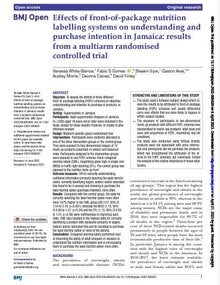Abstract
Objective To assess the effects of three different front-of-package labelling (FOPL) schemes on objective understanding and intention to purchase of products, in Jamaica.
Setting Supermarkets in Jamaica.
Participants Adult supermarket shoppers in Jamaica (n=1206) aged 18 years old or older were included in the study, except for those visually impaired, or unable to give informed consent.
Design Multiarm parallel-group randomised trial.
Interventions Participants were randomly allocated to one of the three intervention groups or the control group. They were exposed to two-dimensional images of 12 mock-up products presented in random and balanced order. Participants assigned to the intervention groups were exposed to one FOPL scheme: black octagonal warning labels (OWL), magnifying glass high-in single icon (MGG) or traffic-light labelling (TFL). The control group was exposed to the nutrition facts up front.
Outcome measures OR for correctly understanding nutritional information (correctly selecting the least harmful option, correctly identifying sugars, sodium and/or saturated fats found to be in excess) and choosing to purchase the least harmful option (purchase intention), more often.
Results Compared with the control group, the odds for correctly selecting the least harmful option more often were 107% higher in the OWL group (OR 2.07, 95% CI 1.54 to 2.78; p<0.001), whereas the MGG (1.18, 95% CI 0.89 to 1.57; p=0.24) and the TFL (1.13, 95% CI 0.85 to 1.51; p=0.39) were inefficacious in improving such odds. OWL also resulted in the highest odds for correctly identifying a product with excessive amounts of sugars, sodium and/or saturated fats and for deciding to purchase the least harmful option or none of the options.
Conclusions Octagonal warning labels performed best at improving the ability of adult shoppers in Jamaica to understand the nutrition information and at encouraging them to purchase the least harmful option more often.
|

